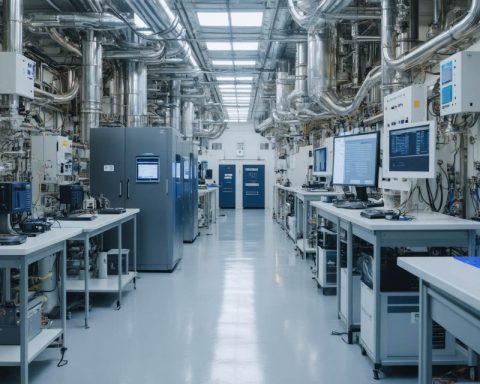European and African ministers recently gathered to reaffirm their commitment to an ambitious renewable energy project. The proposed SouthH2 Corridor aims to transport green hydrogen from North Africa to Europe, facilitating a critical shift towards sustainable energy sources.
This extensive 3,300-kilometer pipeline will begin its journey on the African coast, reaching Italy and extending to Austria and Germany. The Italian energy ministry highlighted that the project is deemed a Project of Common Interest (PCI) by the European Commission, paving the way for potential EU funding for infrastructure development.
According to officials, the SouthH2 Corridor is set to utilize over 65% existing infrastructure, minimizing costs while integrating new pipeline segments where necessary. Notable political backing and strong support from hydrogen production and distribution companies enhance its viability. Anticipated to become operational by 2030, this corridor is expected to solidify Italy’s status as a key energy hub in Europe.
However, the green hydrogen initiative faces challenges, including rising production costs and fluctuating demand uncertainty across Europe. Recent analyses show that competing with established gray hydrogen, derived from natural gas, may take much longer than previously thought, with significant price disparities projected well into the next several decades. As nations seek sustainable solutions, the success of the SouthH2 Corridor could greatly influence the continent’s energy future.
The Broader Implications of the SouthH2 Corridor
The proposed SouthH2 Corridor represents more than just a pipeline; it symbolizes a potential transformation of the global energy landscape. By linking North Africa’s renewable energy resources directly to European markets, this initiative could foster stronger economic ties and collaborations between the two regions. Nations like Italy, which position themselves as logistical hubs, may see a boost in investments and job creation, particularly in green technology sectors, consequently influencing local economies.
On a cultural level, successful implementation can promote greater awareness and acceptance of renewable energy as a viable alternative, shaping public perceptions and policies. As countries grapple with climate change, the move towards green hydrogen could also lead to more integrative energy policies that prioritize sustainability and reduction of carbon footprints globally.
Environmentally, the corridor promises to significantly reduce reliance on fossil fuels, thus lowering greenhouse gas emissions associated with traditional energy resources. The long-term significance lies in its capacity to guide international norms around energy consumption and environmental accountability.
Future trends indicate that as technology advances and economies of scale are achieved, both hydrogen production costs and infrastructure development expenses will likely decrease. This could enable a more robust hydrogen economy in the years ahead, with the SouthH2 Corridor positioned as a linchpin in a renewed commitment to global sustainability initiatives.
Will the SouthH2 Corridor Revolutionize Europe’s Energy Landscape?
The SouthH2 Corridor: A Strategic Green Hydrogen Initiative
Recent commitments from European and African ministers towards the SouthH2 Corridor underline a significant shift in the strategies for sustainable energy production and distribution. The ambitious project aims to transport green hydrogen generated in North Africa to various nations in Europe, marking a pivotal point in the continent’s journey towards a greener energy mix.
Overview of the SouthH2 Corridor
The SouthH2 Corridor is planned as an extensive 3,300-kilometer pipeline that will embark from the African coast, reaching key energy destinations including Italy, Austria, and Germany. Recognized as a Project of Common Interest (PCI) by the European Commission, this classification not only underscores its potential but also opens doors for EU funding, facilitating infrastructure development and integration.
Key Features:
– Extensive Infrastructure Usage: The project plans to utilize over 65% of existing pipeline infrastructure. This strategic decision is expected to effectively lower the overall costs associated with the project while incorporating new segments where necessary.
– Operational Timeline: The SouthH2 Corridor is anticipated to become operational by 2030, positioning Italy as a crucial energy hub within Europe.
Pros and Cons of the SouthH2 Corridor
Pros:
– Sustainability: The corridor will contribute to Europe’s goals of reducing carbon emissions by facilitating the use of green hydrogen.
– Economic Growth: The project could generate numerous jobs in both Europe and North Africa during both construction and operational phases.
– Energy Security: By diversifying energy sources, Europe could reduce dependency on traditional fossil fuels.
Cons:
– Cost Challenges: Production costs for green hydrogen currently remain high, which could impact the corridor’s feasibility.
– Market Uncertainty: The demand for green hydrogen in Europe is still uncertain, posing risks to the project’s long-term viability.
– Competition with Gray Hydrogen: Competing with established gray hydrogen derived from natural gas will shape the competitive landscape for years to come, as projected price disparities suggest a longer time frame for green hydrogen adoption.
Innovations and Future Insights
The SouthH2 Corridor represents not just an innovative approach to energy transport but also a reflection of future energy trends. With rising global emphasis on sustainability, this initiative aligns with broader governmental and organizational efforts aimed at transitioning to renewable energy sources. An external analysis indicates that, if successful, the corridor could significantly alter the dynamics of the European energy market, enhancing collaboration between Africa and Europe.
Security Aspects and Sustainability Considerations
Security of infrastructure and the environmental impact of such a massive project are critical points of discussion. The planning phases of the SouthH2 Corridor must consider protective measures against potential sabotage and the ecological implications of construction and operation. Furthermore, all stakeholders are urged to prioritize sustainability throughout the project’s lifecycle to adhere to Europe’s ambitious climate goals.
Market Analysis: Could It Change the Energy Game?
Experts believe that the marketing of green hydrogen could lead to new economic landscapes in Europe, as competition between varied producers grows. The success of the SouthH2 Corridor will depend heavily on market conditions, technological advancements in hydrogen production, and overall legislative support in favor of green initiatives.
Conclusion: A Energy Future Worth Watching
In summary, while the SouthH2 Corridor is set to play a crucial role in the future of green hydrogen and renewable energy in Europe, its success will rely on navigating the aforementioned challenges. The initiative presents a unique opportunity for collaboration between continents and underscores the importance of innovative approaches to energy sustainability.Learn more about European energy initiatives.













